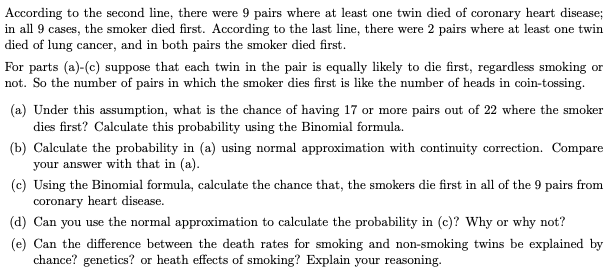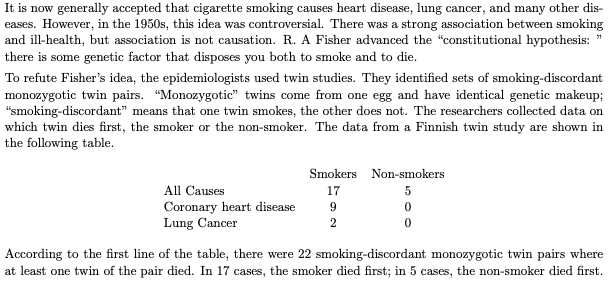It is now generally accepted that cigarette smoking causes heart disease, lung cancer, and many other dis- eases. However, in the 1950s, this idea was controversial. There was a strong association between smoking and ill-health, but association is not causation. R. A Fisher advanced the "constitutional hypothesis: there is some genetic factor that disposes you both to smoke and to die. To refute Fisher's idea, the epidemiologists used twin studies. They identified sets of smoking-discordant monozygotic twin pairs. "Monozygotic" twins come from one egg and have identical genetic makeup; "smoking-discordant" means that one twin smokes, the other does not. The researchers collected data on which twin dies first, the smoker or the non-smoker. The data from a Finnish twin study are shown in the following table. Smokers Non-smokers All Causes 17 5 Coronary heart disease Lung Cancer 9 2 According to the first line of the table, there were 22 smoking-discordant monozygotic twin pairs where at least one twin of the pair died. In 17 cases, the smoker died first; in 5 cases, the non-smoker died first.
It is now generally accepted that cigarette smoking causes heart disease, lung cancer, and many other dis- eases. However, in the 1950s, this idea was controversial. There was a strong association between smoking and ill-health, but association is not causation. R. A Fisher advanced the "constitutional hypothesis: there is some genetic factor that disposes you both to smoke and to die. To refute Fisher's idea, the epidemiologists used twin studies. They identified sets of smoking-discordant monozygotic twin pairs. "Monozygotic" twins come from one egg and have identical genetic makeup; "smoking-discordant" means that one twin smokes, the other does not. The researchers collected data on which twin dies first, the smoker or the non-smoker. The data from a Finnish twin study are shown in the following table. Smokers Non-smokers All Causes 17 5 Coronary heart disease Lung Cancer 9 2 According to the first line of the table, there were 22 smoking-discordant monozygotic twin pairs where at least one twin of the pair died. In 17 cases, the smoker died first; in 5 cases, the non-smoker died first.
MATLAB: An Introduction with Applications
6th Edition
ISBN:9781119256830
Author:Amos Gilat
Publisher:Amos Gilat
Chapter1: Starting With Matlab
Section: Chapter Questions
Problem 1P
Related questions
Question

Transcribed Image Text:According to the second line, there were 9 pairs where at least one twin died of coronary heart disease;
in all 9 cases, the smoker died first. According to the last line, there were 2 pairs where at least one twin
died of lung cancer, and in both pairs the smoker died first.
For parts (a)-(c) suppose that each twin in the pair is equally likely to die first, regardless smoking or
not. So the number of pairs in which the smoker dies first is like the number of heads in coin-tossing.
(a) Under this assumption, what is the chance of having 17 or more pairs out of 22 where the smoker
dies first? Calculate this probability using the Binomial formula.
(b) Calculate the probability in (a) using normal approximation with continuity correction. Compare
your answer with that in (a).
(c) Using the Binomial formula, calculate the chance that, the smokers die first in all of the 9 pairs from
coronary heart disease.
(d) Can you use the normal approximation to calculate the probability in (c)? Why or why not?
(e) Can the difference between the death rates for smoking and non-smoking twins be explained by
chance? genetics? or heath effects of smoking? Explain your reasoning.

Transcribed Image Text:It is now generally accepted that cigarette smoking causes heart disease, lung cancer, and many other dis-
eases. However, in the 1950s, this idea was controversial. There was a strong association between smoking
and ill-health, but association is not causation. R. A Fisher advanced the "constitutional hypothesis:
there is some genetic factor that disposes you both to smoke and to die.
To refute Fisher's idea, the epidemiologists used twin studies. They identified sets of smoking-discordant
monozygotic twin pairs. "Monozygotic" twins come from one egg and have identical genetic makeup;
"smoking-discordant" means that one twin smokes, the other does not. The researchers collected data on
which twin dies first, the smoker or the non-smoker. The data from a Finnish twin study are shown in
the following table.
Smokers Non-smokers
All Causes
17
5
Coronary heart disease
Lung Cancer
9
According to the first line of the table, there were 22 smoking-discordant monozygotic twin pairs where
at least one twin of the pair died. In 17 cases, the smoker died first; in 5 cases, the non-smoker died first.
Expert Solution
This question has been solved!
Explore an expertly crafted, step-by-step solution for a thorough understanding of key concepts.
This is a popular solution!
Trending now
This is a popular solution!
Step by step
Solved in 4 steps with 1 images

Recommended textbooks for you

MATLAB: An Introduction with Applications
Statistics
ISBN:
9781119256830
Author:
Amos Gilat
Publisher:
John Wiley & Sons Inc

Probability and Statistics for Engineering and th…
Statistics
ISBN:
9781305251809
Author:
Jay L. Devore
Publisher:
Cengage Learning

Statistics for The Behavioral Sciences (MindTap C…
Statistics
ISBN:
9781305504912
Author:
Frederick J Gravetter, Larry B. Wallnau
Publisher:
Cengage Learning

MATLAB: An Introduction with Applications
Statistics
ISBN:
9781119256830
Author:
Amos Gilat
Publisher:
John Wiley & Sons Inc

Probability and Statistics for Engineering and th…
Statistics
ISBN:
9781305251809
Author:
Jay L. Devore
Publisher:
Cengage Learning

Statistics for The Behavioral Sciences (MindTap C…
Statistics
ISBN:
9781305504912
Author:
Frederick J Gravetter, Larry B. Wallnau
Publisher:
Cengage Learning

Elementary Statistics: Picturing the World (7th E…
Statistics
ISBN:
9780134683416
Author:
Ron Larson, Betsy Farber
Publisher:
PEARSON

The Basic Practice of Statistics
Statistics
ISBN:
9781319042578
Author:
David S. Moore, William I. Notz, Michael A. Fligner
Publisher:
W. H. Freeman

Introduction to the Practice of Statistics
Statistics
ISBN:
9781319013387
Author:
David S. Moore, George P. McCabe, Bruce A. Craig
Publisher:
W. H. Freeman